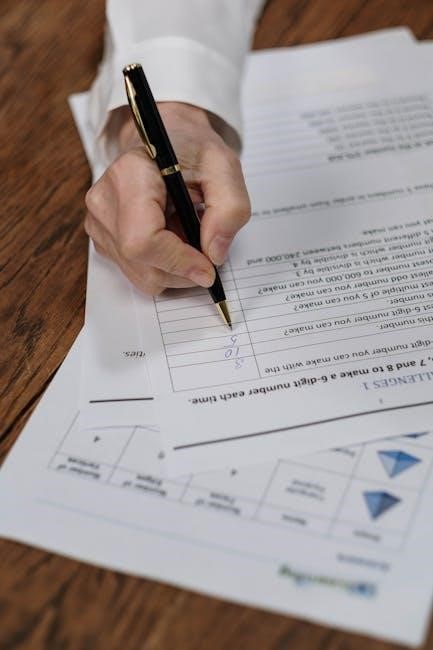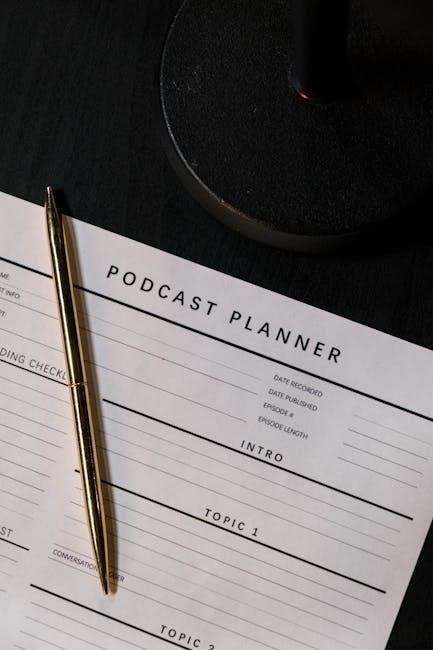Misplaced modifiers are words or phrases incorrectly placed in sentences, causing confusion. Understanding them is essential for clear communication. Practice worksheets with answers help master proper placement, ensuring clarity and effectiveness in writing.
Definition of Misplaced Modifiers
A misplaced modifier is a word, phrase, or clause that is incorrectly placed in a sentence, causing confusion about what it modifies. It does not clearly point to the intended word or phrase, leading to unclear or illogical meaning. For example, in the sentence “She almost drove her kids to school,” the modifier “almost” incorrectly suggests that she didn’t fully drive them. Proper placement is essential for clear communication. Misplaced modifiers can be adjectives, adverbs, or phrases, and their incorrect placement disrupts sentence clarity. Understanding and correcting them is crucial for effective writing, as highlighted in worksheets with answers.
Importance of Understanding Misplaced Modifiers
Understanding misplaced modifiers is crucial for clear and effective communication. Misplaced modifiers can confuse readers, altering the intended meaning of sentences. For instance, “She almost drove her kids to school” implies she didn’t complete the action, while “She drove her kids almost to school” suggests they didn’t reach. Mastering proper modifier placement enhances writing clarity, professionalism, and academic performance. Worksheets with answers provide practical exercises to identify and correct misplaced modifiers, reinforcing learning and improving writing skills. Clear communication relies on accurate modifier placement, making it essential for effective expression in both personal and professional contexts.

What Are Misplaced Modifiers?
Misplaced modifiers are words or phrases awkwardly placed in sentences, causing ambiguity about what they modify. They disrupt clarity and often lead to confusing interpretations.
Examples of Misplaced Modifiers
Misplaced modifiers often disrupt sentence clarity. For instance, in the sentence, “The vehicle had a flat tire when we bought it last week,” the modifier “last week” is misplaced, suggesting the tire was flat when purchased. Similarly, “She almost drove her kids to school” implies the driving was nearly done, not the action of driving. Another example: “Hunters finger from the beach trip was stung by the jellyfish,” where “from the beach trip” incorrectly modifies “finger.” These examples highlight how misplaced modifiers can confuse the intended meaning, making sentences ambiguous or illogical. Correct placement is essential for clear communication.
How Misplaced Modifiers Affect Sentence Clarity
Misplaced modifiers disrupt sentence clarity by creating ambiguity. When a modifier is not placed near the word it describes, readers may misinterpret the intended meaning. For example, in “The bracelet on Jane’s wrist, which we bought at the store, was stolen,” the phrase “which we bought at the store” incorrectly modifies “wrist” instead of “bracelet.” This confusion can lead to misunderstandings. Clear placement ensures the modifier directly relates to the correct noun or verb, maintaining logical flow and precise communication. Addressing misplaced modifiers is crucial for effective writing, as they can alter the sentence’s intended message entirely.

Common Types of Misplaced Modifiers
Misplaced modifiers include adjectives, adverbs, phrases, and clauses. Each type can disrupt clarity when not placed correctly, affecting the sentence’s meaning and overall effectiveness.
Adjectives as Misplaced Modifiers
Adjectives often cause issues when misplaced. For example, in “She almost drove past the house,” “almost” correctly modifies “drove.” However, in “She drove almost past the house,” the meaning shifts, implying she nearly passed it. Misplaced adjectives can confuse readers about what is being described. Worksheets with answers highlight such errors, helping to identify and correct them. Proper placement ensures the intended meaning is clear; Regular practice with exercises helps writers avoid these common mistakes, improving sentence clarity and overall communication.
Adverbs as Misplaced Modifiers
Adverbs, like “quickly” or “very,” often function as misplaced modifiers when their placement confuses the sentence meaning. For example, “She spoke loudly to her friend” correctly places “loudly” to modify “spoke.” However, in “She spoke to her friend loudly,” the adverb’s position might imply her friend is loud. Misplaced adverbs can alter intended meaning. Worksheets with answers provide exercises to identify and correct such errors, ensuring adverbs are placed near the words they modify. Practice helps writers avoid ambiguity, making their writing clearer and more precise.
Phrases as Misplaced Modifiers
Phrases can also act as misplaced modifiers, disrupting sentence clarity. For instance, “While driving, the tree appeared suddenly,” makes it seem the tree was driving. Correctly placing the phrase near “appeared” clarifies the meaning. Worksheets with answers highlight such errors, offering exercises to reposition phrases accurately. Practice helps writers ensure phrases modify the intended words, avoiding confusion. By mastering phrase placement, writers enhance sentence structure and readability, essential for effective communication.
Clauses as Misplaced Modifiers
Clauses can also function as misplaced modifiers, leading to unclear or illogical sentences. For example, “While driving, the tree appeared suddenly,” suggests the tree was driving. This misplaced clause confuses the sentence’s meaning. Correct placement involves moving the clause closer to the intended subject, as in, “While driving, I saw the tree appear suddenly.” Worksheets with answers often highlight such errors, providing exercises to correct clause placement. By practicing proper clause positioning, writers ensure clarity and logical sentence structure, avoiding misunderstandings. This helps improve overall writing effectiveness and readability.

How to Identify Misplaced Modifiers
Identify misplaced modifiers by carefully reading sentences and checking if modifiers are placed near the words they describe. Look for clarity and logic to ensure proper meaning is conveyed.
Reading Sentences Carefully
Reading sentences carefully is the first step in identifying misplaced modifiers. By examining each word’s relationship to others, you can determine if the modifier is correctly placed. Pay attention to how each phrase or clause relates to the subject and verb. If a word or phrase seems to describe the wrong part of the sentence, it may be misplaced. This method ensures clarity and helps avoid confusion. Regular practice with worksheets, such as those found in the moved here to avoid duplication PDF, enhances your ability to spot these errors effectively. Consistent review improves writing accuracy and overall sentence structure.
Looking for Modifier Placement
When identifying misplaced modifiers, focus on the placement of adjectives and adverbs in relation to the words they describe. Modifiers should be placed as close as possible to their targets to avoid ambiguity. For example, in the sentence “She almost drove her kids to school,” the modifier “almost” clearly describes the verb “drove.” However, in “She drove her kids to school almost,” the placement is awkward, changing the meaning. Practice worksheets, like those in the moved here to avoid duplication PDF, provide exercises to help recognize correct and incorrect modifier placement, ensuring clarity and precision in writing.
Checking for Clarity and Logic
After identifying potential misplaced modifiers, the next step is to assess the sentence for clarity and logic. A sentence with misplaced modifiers can confuse readers by making it unclear which word or phrase the modifier describes. For example, in “The teacher assigned the homework to the students quickly,” it is unclear whether “quickly” describes the assignment or the completion of the homework. To ensure clarity, modifiers should be placed directly before or after the words they modify. Worksheets with answers, such as those in the moved here to avoid duplication PDF, provide exercises to help learners evaluate sentences and correct illogical modifier placements, reinforcing proper grammatical structure and clear communication.

How to Correct Misplaced Modifiers
To correct misplaced modifiers, ensure they are placed directly before or after the word they modify. This enhances clarity and logical sentence structure. Use punctuation effectively to guide meaning. For example, in “The students could see the shuttle launch from the school,” moving “from the school” closer to “launch” clarifies the modifier’s target. Rewriting sentences and using worksheets with answers can help master this skill, ensuring clear communication in writing.
Moving Modifiers Closer to the Target
Moving modifiers closer to their intended targets is a key step in correcting misplaced modifiers. By placing the modifier near the word it describes, the sentence becomes clearer. For example, in the sentence “The students could see the shuttle launch from the school,” moving “from the school” closer to “launch” clarifies that the school is the location of the launch. This simple adjustment ensures that the modifier accurately conveys the intended meaning. Worksheets with answers provide practical exercises to help writers master this technique, improving sentence clarity and effectiveness in their writing.
Rewriting Sentences for Clarity
Rewriting sentences for clarity is essential when correcting misplaced modifiers. This involves reorganizing the sentence structure to ensure modifiers are placed logically. For instance, the sentence “Hunters finger from the beach trip was stung by the jellyfish” can be rewritten as “The hunter’s finger, which was from the beach trip, was stung by the jellyfish.” This revision makes it clear that the jellyfish stung the hunter’s finger. Worksheets with answers provide examples and exercises to help identify and correct such issues, ensuring that sentences are both grammatically correct and easy to understand. This practice enhances writing precision and readability.
Using Punctuation Effectively
Using punctuation effectively is crucial in correcting misplaced modifiers. Commas, dashes, and parentheses can help clarify the relationship between modifiers and the words they describe. For example, in the sentence “The bracelet on Jane’s wrist which we bought at the store was stolen,” adding commas around the relative clause (“which we bought at the store”) ensures the modifier clearly describes “bracelet.” Proper punctuation guides the reader, preventing confusion about what the modifier is emphasizing. Worksheets with answers often highlight the role of punctuation in resolving misplaced modifier issues, demonstrating how it enhances sentence clarity and logical flow. This practice helps writers avoid ambiguity in their writing.

Misplaced Modifiers Worksheet
This worksheet helps identify and correct misplaced modifiers in sentences, improving clarity and logic. It includes exercises like identifying modifiers, rewriting sentences, and multiple-choice questions, with an answer key for accuracy.
Identifying Misplaced Modifiers in Sentences
Identifying misplaced modifiers involves analyzing each sentence to determine if the modifier is correctly placed. Look for words, phrases, or clauses that seem to describe the wrong word. For example, in the sentence “Hunters finger from the beach trip was stung by the jellyfish,” the phrase “from the beach trip” is a misplaced modifier because it incorrectly describes “finger” instead of “hunters.” Circle the misplaced modifier if found and label it as MM. This exercise helps develop a keen eye for sentence structure and modifier placement, ensuring clear and logical communication. Regular practice improves writing accuracy and reduces misunderstandings.
Rewriting Sentences with Correct Modifier Placement
Rewriting sentences with correct modifier placement ensures clarity and proper meaning. For example, the misplaced sentence “Hunters finger from the beach trip was stung by the jellyfish” should be rewritten as “The hunter’s finger, which was from the beach trip, was stung by the jellyfish.” This revision places the modifier “from the beach trip” closer to “finger,” eliminating confusion. Another example: “The students could see the shuttle launch from the school” becomes “From the school, the students could see the shuttle launch.” Always move modifiers closer to the words they describe to avoid ambiguity and improve sentence logic. Regular practice helps refine this skill, enhancing overall writing clarity.
Multiple-Choice Questions on Modifier Placement
Multiple-choice questions on modifier placement test understanding of correct sentence structure. For example:
- Which sentence correctly places the modifier?
- The students could see the shuttle launch from the school.
- From the school, the students could see the shuttle launch.

- Identify the sentence with correct modifier placement:
- Hunters finger from the beach trip was stung by the jellyfish.
- The hunter’s finger, which was from the beach trip, was stung by the jellyfish.
These questions help learners apply placement rules and avoid ambiguity. Answers are provided for self-assessment, ensuring improved clarity in writing. Regular practice with such exercises enhances mastery of modifier placement.

Answers to Misplaced Modifiers Worksheet
The vehicle had a stuck accelerator.
The bracelet on Jane’s wrist was purchased at the store.
The drink did not work hard all day in the sun.
Emma Sue was delighted when Mr. Nguyen returned her paper.
Keys to multiple-choice questions available in the worksheet.
Common mistakes include placing modifiers too far from the target word, causing confusion. Always place modifiers near the word they describe for clarity.
Corrected Sentences with Explanations
Original: “The students could see the shuttle launch from the school.”
Corrected: “The students from the school could see the shuttle launch.”
Explanation: Moving “from the school” closer to “students” clarifies that the students were at the school, not the shuttle launch. This placement ensures the modifier describes the correct noun, improving sentence clarity and grammatical accuracy.
Keys to Multiple-Choice Questions
Correct Answer: B
Explanation: The modifier “from the beach trip” was misplaced. It should describe “hunters,” not “finger.” The corrected sentence is: “Hunters from the beach trip had their finger stung by the jellyfish.”
Correct Answer: A
Explanation: The sentence is written correctly. The modifier “on Jane’s wrist” properly describes “the bracelet.” No revision is needed.
Correct Answer: C
Explanation: The modifier “in the sun” was misplaced. It should describe “the drink,” not “work hard.” The corrected sentence is: “The drink, which did not work hard, was left in the sun all day.”
Common Mistakes and Their Solutions
One common mistake is placing modifiers too far from the word they describe, leading to confusion. For example, in “Having studied all night, the exam was easy,” the modifier “Having studied all night” incorrectly describes “the exam.” To fix this, rephrase to “After studying all night, the student found the exam easy.” Another error is using ambiguous modifiers like “only,” which can modify multiple words. Ensure modifiers are placed directly before or after the intended word. Regular practice with worksheets helps identify and correct these issues, improving sentence clarity and effectiveness in communication.
Mastering misplaced modifiers is crucial for clear writing. Regular practice with worksheets ensures proper placement, enhancing communication and making sentences precise and highly effective.
Misplaced modifiers are words or phrases incorrectly placed in sentences, leading to confusion. They can be adjectives, adverbs, phrases, or clauses. Identifying them requires careful reading and understanding their intended targets. Correct placement ensures clarity and logical meaning. Worksheets with answers provide practical exercises to master proper modifier placement. These resources help learners avoid common mistakes and improve writing precision. Regular practice enhances the ability to spot and correct misplaced modifiers, ensuring clear and effective communication in written English.
Final Tips for Avoiding Misplaced Modifiers
To avoid misplaced modifiers, always place them close to the words they describe. Read sentences carefully to ensure clarity. Use worksheets with answers to practice identification and correction. Regularly reviewing modifier placement strengthens writing skills. Pay attention to adjectives, adverbs, phrases, and clauses. Ensure each modifier clearly modifies the intended word. Use punctuation effectively to enhance sentence structure. By following these tips, writers can produce clear, logical, and professional text, avoiding the confusion caused by misplaced modifiers. Consistent practice with exercises leads to better mastery of proper modifier placement in writing.

Additional Resources
Recommended Worksheets and Exercises
Utilize worksheets with answers to practice identifying and correcting misplaced modifiers. These resources provide hands-on experience for improving writing clarity and grammar skills effectively.
Online Tools for Practicing Modifier Placement
Explore online tools and exercises that offer interactive lessons and quizzes to help master proper modifier placement and avoid common grammatical errors in sentences.
Grammar Guides for Further Reading
Consult comprehensive grammar guides for in-depth explanations and examples of misplaced modifiers. These resources offer detailed insights for advancing your understanding of modifier usage and placement.

Engage with downloadable PDF worksheets specifically designed to identify and correct misplaced modifiers. These resources often include exercises with answers, providing clear guidance and examples to enhance learning. Many worksheets feature multiple-choice questions, fill-in-the-blank activities, and sentence rewriting tasks to reinforce proper modifier placement. Interactive online tools also offer quizzes and immediate feedback, making practice both effective and engaging. For additional practice, seek out printable exercises that focus on real-world sentences, allowing you to apply your knowledge in practical scenarios. Utilize these resources consistently to build confidence and mastery over modifier usage in your writing.
Utilize online tools and platforms designed to help practice modifier placement effectively. Websites like Purdue OWL and Khan Academy offer interactive exercises and quizzes to test your understanding of misplaced modifiers. Many online resources provide immediate feedback, allowing you to identify and correct errors in real-time. Some platforms include timed challenges and progress tracking features, making learning engaging and efficient; Additionally, grammar-focused websites often feature specialized sections dedicated to modifier placement, with examples and exercises tailored to different skill levels. These tools are ideal for self-paced learning and can complement traditional worksheets for a well-rounded approach to mastering misplaced modifiers.
Enhance your understanding with comprehensive grammar guides that delve into misplaced modifiers. Classic resources like The Elements of Style by Strunk and White provide clear guidelines and examples. Modern guides such as Grammar Girl and Purdue OWL offer detailed explanations and exercises. These resources are ideal for further reading, as they explore the nuances of modifier placement in depth. Many guides include practical examples, making complex concepts accessible. Whether you’re a student or a professional, these resources are invaluable for refining your writing skills and ensuring clarity in your sentences. They complement worksheets by offering theoretical insights and practical applications.



